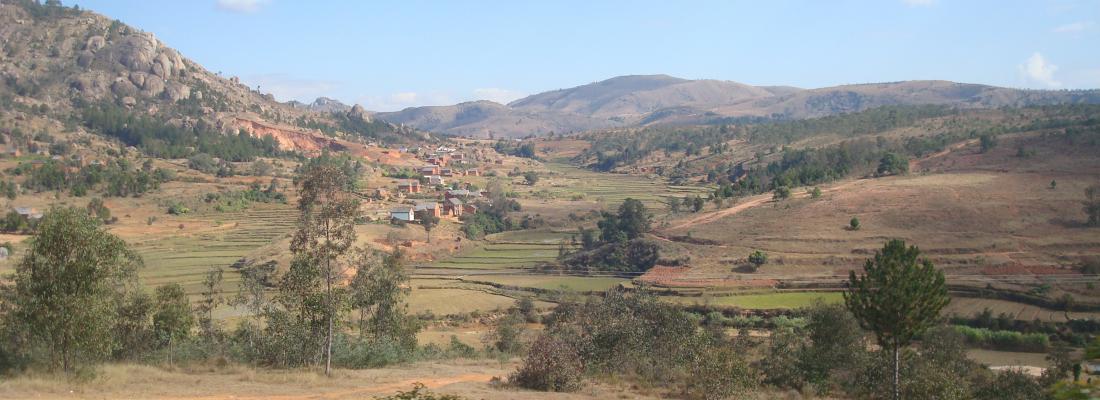Climate change and risks 4 min
Agrimonde-Terra foresight study on ‘Land use and food security in 2050’
Following their first Agrimonde foresight study published in 2011 on ‘World food security in 2050’, INRA and CIRAD have turned their attention to the drivers of land use changes and their connections to world food security and climate. By 2050, the world’s land areas will have to feed an estimated population of 9.7 billion people while playing a supporting role to global forests in controlling climate change.
Published on 24 June 2016

The Agrimonde-Terra foresight study examines five contrasting scenarios to identify and quantify the main drivers of land use changes in the world and their links to food and climate change.
Five scenarios
Two trending scenarios with extreme consequences are put forward: the “Metropolization” scenario, characterized by growth at any cost, with a transition to more highly-processed and animal food products; and the “Communities” scenario, which envisions a world subject to recurring crises and increased regional fragmentation, leading to slower growth and stagnation – or even the collapse – of crop yields, in turn creating uncertainty for the global food supply.
Five alternative scenarios have been imagined
Between these two extremes are three alternative scenarios developed with international experts on the Scenario Advisory Committee. The first, “Healthy”, imagines healthy food diets in terms of nutrition and quantity, based on diversified agricultural production. The “Regionalization” scenario has each region of the world developing its own “food sovereignty” strategy by reducing trade with outside regions to a minimum. Changes in regional agriculture will be necessary to return to the traditional food diets implicit in this scenario. The last scenario, “Households”, carves out a major role for cooperatives and family farming. It couples strong mobility between rural and urban areas with hybrid food diets combining traditional and modern foods.
Few alternatives
Feeding the world high-quality food in sufficient quantities, developing agroecological farming systems and practices and conserving forests at a time of climate change are a set of objectives that are difficult to achieve simultaneously.
Areas dedicated to forests tend to decrease.
Regardless of the scenario, forests tend to be razed to make way for farmland. This tension is at its highest in the “Metropolization” and “Communities” scenarios. The “Healthy” scenario is the only one that will allow for forest land to be maintained alongside the development of more sustainable farming systems. In all scenarios, international trade will remain necessary, including in the “Regionalization” scenario, which has a stated objective of reducing trade.
Sub-Saharan Africa, whose population is expected to double by 2050 and for which crop yields and availability of calories are currently very low, is under considerable tension. Forest land is declining and available non-forest land is not sufficient. This situation is mirrored – although to a lesser degree – in India, while North Africa and the Middle East have an increased dependence on agricultural imports. Countries such as Argentina and Brazil, where cash crops are prevalent, experience disturbances in their agricultural economies to their agricultural productions being rerouted to serve their own food supply needs.
The “Healthy” scenario offers a better outcome in terms of the relationship between food and health: both undernutrition and diseases linked to overnutrition are reduced. The “Metropolization” scenario shows an epidemic rise in diseases linked to overnutrition, while the “Communities” scenario increases the risk of food crises. The results are less clear-cut for the other two scenarios.
Achieving all the objectives will require pro-active, coordinated public policies
The challenge is to succeed in building global governance.
The “Healthy” scenario is the only one with a food supply that promotes health and eco-friendly farming practices and land uses. Achieving this precarious balance will require strong, coordinated public policies. A system of global governance will need to be developed for food security and land use to avert food crises, land grabs and deforestation and to attenuate climate change effects.
Such global governance must take into account regional differences and involve international institutions, governments, civil society, industrial players, etc. Transitions to healthier and more diverse food diets must be encouraged, while loss and waste along the entire food chain – from field to plate – must be reduced. Overall, consumption of animal products must decline (except in Sub-Saharan Africa and India) and be replaced with cereals, pulses, fruits and vegetables. Public policies must support these transitions through subsidies, pricing policies and education. Transitions to more agroecological farming and livestock systems must also be encouraged. Clear rules for international trade must guarantee stable access to food while taking the environment into consideration. Lastly, policies must secure access to land for all types of farming at different geographical scales. To do this, rural populations will need to participate in applying rural development policies and protecting common goods at the national and regional levels.
The Agrimonde prospective, delivered in 2011.
Agrimonde-Terra Organisation
This foresight study by INRA and CIRAD called on 80 international experts who participated in thematic workshops or as members of the Scenario Advisory Committee, the joint INRA/CIRAD project team of scientific coordinators of the thematic workshops, or the steering committee. It is part of the research priority on global food security, a focus of the INRA/CIRAD cross-disciplinary research programme “GloFoodS Metaprogramme”.
